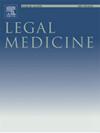Strontium concentration in body cavity fluids as a novel marker for drowning diagnosis and entry site determination
IF 1.4
4区 医学
Q3 MEDICINE, LEGAL
引用次数: 0
Abstract
We started to measure concentrations of dissolved and particulate phases for dozens of chemical elements to compensate for the shortcomings of the diatom test. In this study, pleural, peritoneal, pericardial, and cerebrospinal body fluids were obtained from 34 cases diagnosed as drowning and 25 non-drowning and non-immersed (NDNI) cases. The results showed that from the body fluids, in particular from bilateral pleural and pericardial fluids, synergically measured levels of the dissolved phase of strontium (Sr), lithium (Li), and Boron (B) and particulate phase of Sr concentrations were increased in seawater drowning (SWD) cases as opposed to freshwater drowning (FWD) cases and NDNI cases, forecasting the location of water aspiration. To categorically attribute the cause of death to drowning, however, a comprehensive investigation of circumstantial evidence, a careful external examination of the body, and a thorough analysis of body fluids pertaining to diatom testing in various organs and body fluids should be undertaken. Our research with the latter analysis method reveals that it is a powerful diagnostic aid, particularly in SWD cases versus FWD cases. Going forward, we hope that the results we achieved will be helpful when investigating drowning location with water aspiration for suspected drowning cases.
体腔液体中锶浓度作为溺水诊断和进入部位测定的新标志物
我们开始测量几十种化学元素的溶解相和颗粒相的浓度,以弥补硅藻测试的不足。在本研究中,采集了34例诊断为溺水和25例非溺水和非浸入(NDNI)病例的胸膜、腹膜、心包和脑脊液。结果表明,从体液,特别是双侧胸膜和心包液中,海水溺水(SWD)病例中锶(Sr)、锂(Li)和硼(B)的溶解相水平和颗粒相Sr浓度的协同测量水平高于淡水溺水(FWD)病例和NDNI病例,预测了水吸入的位置。然而,为了明确地将死亡原因归因于溺水,应对间接证据进行全面调查,对尸体进行仔细的外部检查,并对体液进行彻底分析,以便在各种器官和体液中进行硅藻测试。我们对后一种分析方法的研究表明,它是一种强大的诊断辅助手段,特别是在SWD病例与FWD病例中。展望未来,我们希望我们的研究结果能对调查疑似溺水个案的吸水地点有所帮助。
本文章由计算机程序翻译,如有差异,请以英文原文为准。
求助全文
约1分钟内获得全文
求助全文
来源期刊

Legal Medicine
Nursing-Issues, Ethics and Legal Aspects
CiteScore
2.80
自引率
6.70%
发文量
119
审稿时长
7.9 weeks
期刊介绍:
Legal Medicine provides an international forum for the publication of original articles, reviews and correspondence on subjects that cover practical and theoretical areas of interest relating to the wide range of legal medicine.
Subjects covered include forensic pathology, toxicology, odontology, anthropology, criminalistics, immunochemistry, hemogenetics and forensic aspects of biological science with emphasis on DNA analysis and molecular biology. Submissions dealing with medicolegal problems such as malpractice, insurance, child abuse or ethics in medical practice are also acceptable.
 求助内容:
求助内容: 应助结果提醒方式:
应助结果提醒方式:


